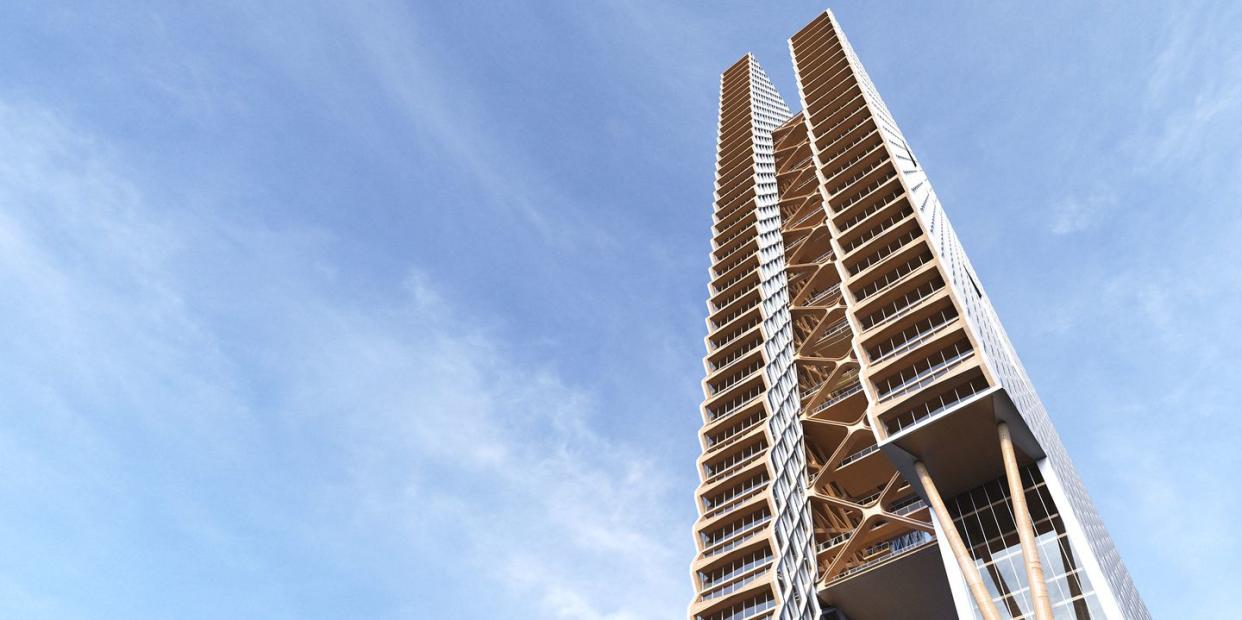Mass Timber, Not Steel, Is the Future of Construction

Fire-blocking mass timber construction could bring millions of pounds of carbon absorption to cities around the world.
Wooden skyscraper designs are trendy around the world and reflect changing attitudes about wood construction.
Making construction-grade timber can also cost less in carbon emissions than concrete and steel.
Could fire-blocking timber construction be part of the carbon-neutral city of the future? Scientists from Germany’s Potsdam Institute for Climate Impact Research think so. In a new paper, they argue that timber construction could become a critical carbon sink in cities around the world, acting in much the same way that trees do. Researchers say that the “mass timber” style of construction is fundamentally fire-safe, and other groups around the world continue to work on making truly non-combustible wood products to completely put the issue to bed.
If a building is made with a solid wooden structure, it isn’t consumed by fire the same way plywood is, for example. Plywood has flammable glue, making it more vulnerable than solid wood. Medium density fiberboard (MDF) and oriented strand board (OSB) are both also pretty flammable. But solid wood tends to burn on the outside while the inside remains untouched, like trying to start a campfire by throwing in only solid logs.
Mass timber code is different from light wood frame construction, where the very thin pieces of wood, like structural 2x4s, are also vulnerable to fire. Large, structural pieces of mass timber are made from putting together solid wood boards together to make walls and other components. “[T]he International Building Code developed by the International Code Council, which is the base for most jurisdictions in the U.S., was recently updated to recognize mass timber as ‘acceptable for fire blocking,’” Fast Company says.
That means fire-safe mass timber is a great candidate for construction—and researchers say its ability to absorb carbon makes it not just attractive but important to the city of the future. Once a comprehensive new building code for mass timber is in place, even an increase to 10 percent mass timber construction (with the rest as status quo concrete and steel) would create a carbon sink of 10 million tons of absorbed carbon per year.
The researchers emphasize that their model relies on sustainable forestry only, and they say two thirds of the countries they studied for this paper already have a surplus of lumber compared with minimum sustainable levels. And there’s a second way mass timber construction can impact emissions: Both concrete and steel generate giant amounts of carbon emissions, and the construction industry overall makes up 30 percent of annual greenhouse gases. Making concrete requires extremely high heat, and so does making steel. Both could shift to cleaner fuels like hydrogen in the future, but wood is cleaner today.
In Chicago, architects have proposed a wooden skyscraper 80 stories tall, the River Beech Tower, which is just one of a wave of proposed and planned wooden skyscrapers around the world. It follows an award-winning 2013 idea for a 30-story tower named, uh, Big Wood. But wood is lighter, easier to work with in many ways, and more insulating—so really, big wood could be right around the corner.
You Might Also Like


